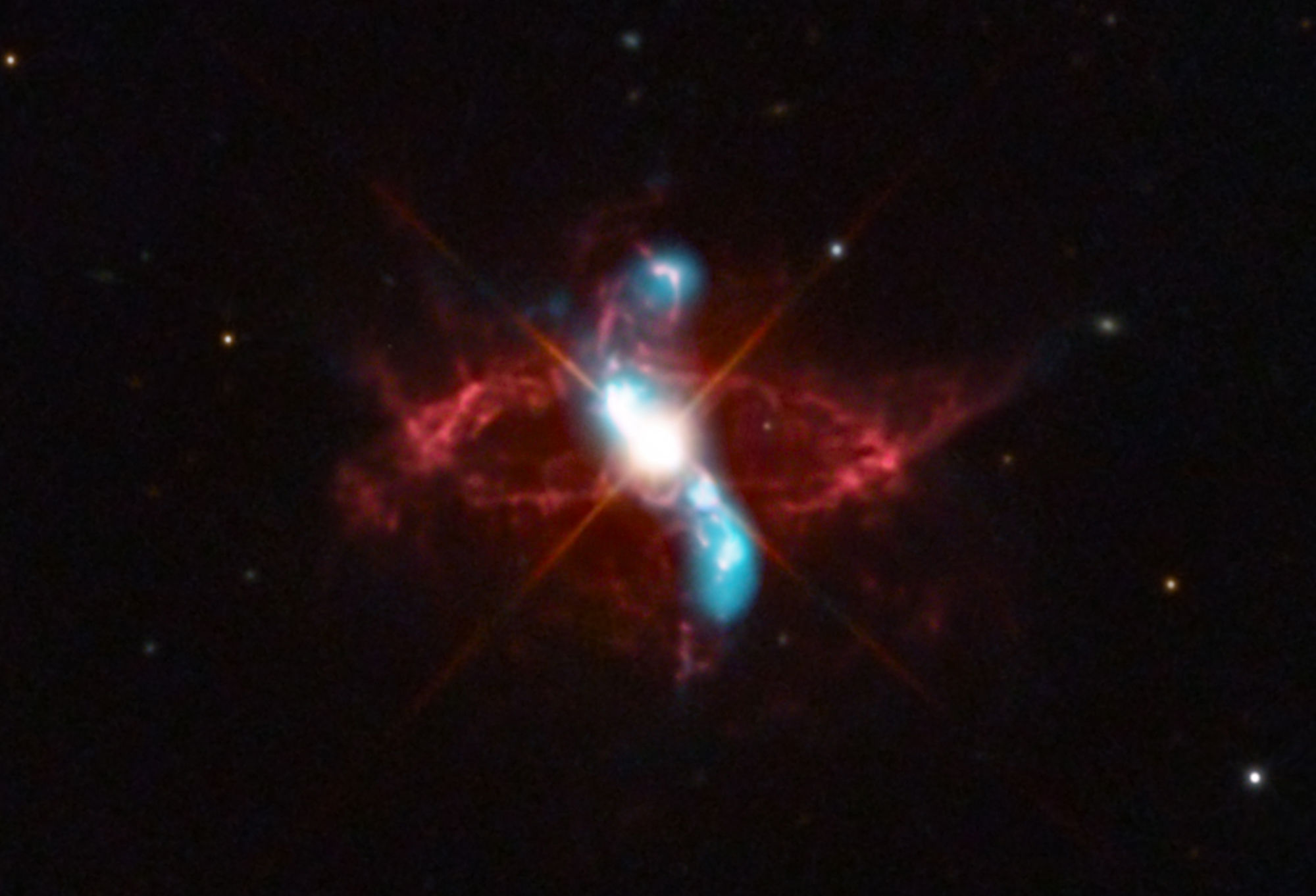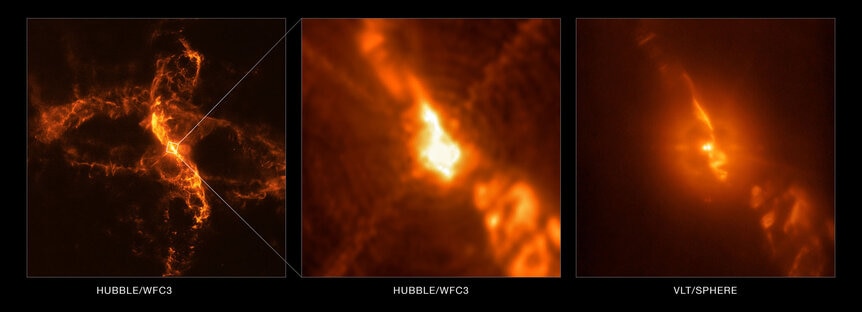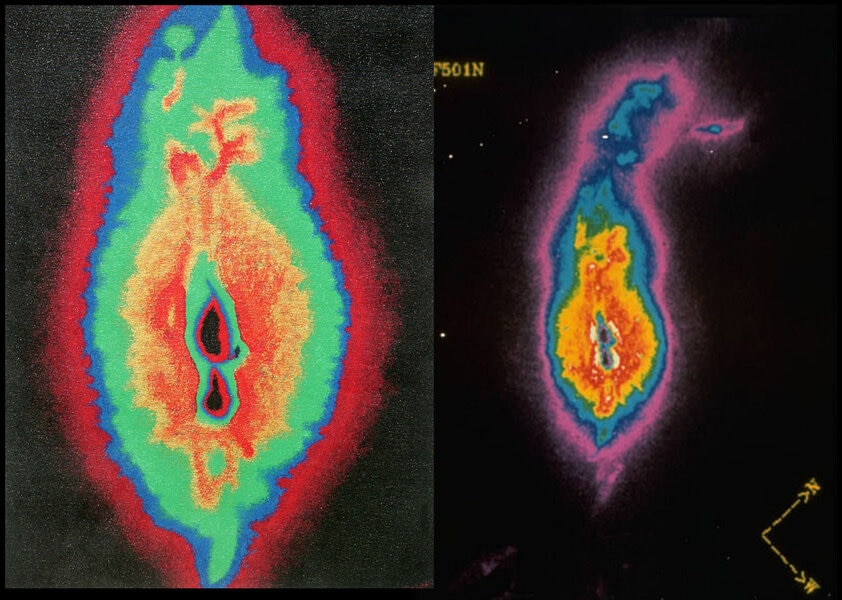Create a free profile to get unlimited access to exclusive videos, sweepstakes, and more!
The recurrent exploding nova R Aquarii: Unlucky Stars

Life is funny. Maybe you've heard. I wasn't sure at first, but now I'm a Believer.
Let's start 650 light years way, in the direction of the constellation Aquarius. There's a star there that is decidedly odd. Called R Aquarii*, it's the swollen hulk of a star that was once much like the Sun, but is now nearing the end of its life. Complicated processes in the core have dumped huge amounts of energy into the outer layers of the star, and when you heat up a gas it expands. But, it gets so big that the amount of energy it emits per square centimeter actually goes down, so its temperature drops as well. Cooler stars emit redder light, so we call these stars red giants.
Some red giants are relative stable, but some are not. They expand and contract, physically getting larger and smaller. A small instability inside the star triggers this pulsing. As they contract they get hotter, which increases pressure inside the star, so it responds by slowing, stopping, and reversing the contraction. But then they get really big, the pressure drops, and they contract again. Lather, rinse, repeat. This back-and-forth can go on for a long time, with cycles lasting about a year or so. The luminosity of the star changes too, sometimes by a factor of a hundred or more!
Stars that change brightness are called variable stars, and ones like these are called Mira variables, after the star Mira, the prototype.
Adding to the confusion is that this red giant is not All Alone in the Dark. It has a companion… and it's good and dead. This also used to be a star like the Sun, but used up all its fuel long ago. It was a red giant for a while, but eventually blew off all its outer layers, revealing the hot, dense core of the star: a white dwarf.
The white dwarf orbits the red giant every 44 years or so, although the exact period is unknown. But they are pretty close together, especially since the red giant is so huge. Even better, the white dwarf doesn't make a Circle Sky; the orbit is elliptical, so sometimes it gets closer to the red giant. When the white dwarf gets close enough, material from the giant falls onto the dwarf. While it's Goin' Down, this matter forms a flat disk called an accretion disk, which slowly feeds the material onto the dwarf's surface.
Because these Unlucky Stars are connected, we call them symbiotic binaries. That's a bit of a misnomer, since the white dwarf doesn't do anything for the red giant. It's really a more of a parasitic binary. #pedantry
Anyway, not all the material from the red giant hits the dwarf, though. Strong magnetic fields can actually lift this matter off the disk, blowing it away into space in twin beams, up and down relative to the disk. We call these jets, and they can be light years long. R Aquarii has a pair of these jets, and they're curved; this is generally the calling card of precession, a wobbling of the rotational axis of the white dwarf (a top spinning rapidly will appear to slowly wobble due to friction with the table top; this is the same sort of thing). The jets appear to curve due to the Lawn Sprinkler Effect; the gas is blown straight out, but the spinning axis of the dwarf makes them appear to curve over time. Also, the jets are blobby, which means the flow of material isn't smooth, but they're quite long and appear stable, indicating this is a continuous process and has been going on for a long time.
But…
Material from the red giant is still raining down on the white dwarf. As the matter piles up, the intense gravity of the dwarf (hundreds of thousands of times stronger than Earth's) squeezes this stuff mightily. If enough material accumulates, there is so much pressure that it can spontaneously fuse, converting hydrogen into helium… plus a lot of energy. A lot. This is the same reaction that powers hydrogen bombs and stars, so it's a vast amount of energy, and it's released all at once.
The material explodes, blasting off the dwarf's surface and screaming into space. This is what we call a nova.
Surrounding R Aquarii is a complex system of shells and rings of material. This is likely from previous nova events, which, intriguingly, may have been witnessed by Korean astronomers in the years 1073 and 1074 AD.
Once the nova settles down, material starts to flow again, piling up slowly. The jets start back up, but eventually another explosion will occur. And it happens Time and Time Again, so we call these systems recurrent novae.
R Aquarii has a lot of designations. So many Words for one kind of system!
You can actually see the expansion of the material yourself in a before-and-after slider from images taken 15 years apart. I really urge you to go look at that link; it's extremely cool. There's also this nifty short animation:
Cool! It's not too often you can see changes in astronomical objects like this!
So. A while back I was poking around the web looking for images of R Aquarii while doing some reading about symbiotic binaries. One of them stuck out at me because it looked familiar, but not quite right. I clicked on it, and found to my delight that it was a painting of the system done by an artist! It was based on observations done by Hubble not too long after the observatory launched, when the images were still all out of focus. The image was taken in only a single filter, so it should be shown in Shades of Gray, but the press released used "false" color for it:
Not bad, right? A little bit of interpretation there, but I thought it looked OK.
Then I checked the artist's name: Mickey Dolenz.
Like, yeah. Mickey Dolenz, lead singer of The Monkees. My favorite band when I was a kid, and, to be quite honest, still a fave now.
I laughed out loud! I didn't know Mickey was a painter! It turns out he's done quite a few pieces based on science, mostly microbiology, but in this case he was a Star Collector. Cool.
Still, I wanted to kick myself. A few years back I was at a science fiction convention, and when I walked into the big room where various pop culture celebs and such autograph things, standing right there was Mickey! What Was He Doing Hanging 'Round? I didn't know, but no one was talking to him, so I walked up, introduced myself and chatted with him for a minute. It was great, and he was lovely.
But how I wished I had known he had painted R Aquarii at the time! That would've been amazing to talk to him about it and see why he picked that particular object. If I could've answered any of his questions it would've been a dream come true. I hope I meet him again. Someday, man.
Still, That Was Then, This Is Now. In lieu of talking to him, I get to talk to all of you. If you have questions, leave a comment below! That way It's a Little Bit Me, and A Little Bit You.
In many cases a star in a constellation is given a letter or number designation followed by the genitive case of the constellation's name. For names ending in "us" that's changed to "i," so Aquarius becomes Aquarii, and It's pronounced uh-KWARE-ee-eye. In case you were curious and trying to pronounce it in your head. Other example are Piscium for Pisces, Capricornus for Capricorn, and Jones, Ltd.





























